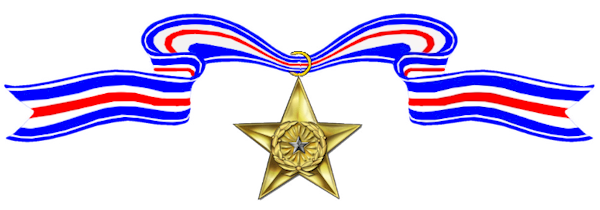William Outerson graduated from the U.S. Naval Academy at Annapolis, Class of 1932. He retired as a U.S. Navy Captain.

–
Home:
,
Awards Received
-

Silver Star
-

Silver Star
-
Silver Star
Service:
United States NavyRank:
CommanderDivision:
U.S.S. Plunkett (DD-431)Action Date:
June 6 & 25, 1944
Commander 12th Fleet: Serial 10565 (October 30, 1944)The President of the United States of America takes pleasure in presenting the Silver Star to Commander William Outerson (NSN: 0-71443), United States Navy, for conspicuous gallantry and intrepidity as Commanding Officer of the U.S.S. PLUNKETT (DD-431), attached to the TWELFTH Fleet, in action against enemy forces during the amphibious assault on Normandy, France, 6 June 1944, and the bombardment of enemy defenses at Cherbourg, France, 25 June 1944. Maneuvering his ship through heavily mined waters to protect vessels of the Western Task Force area from enemy surface forces and submarines, Commander Outerson steadfastly maintained his position in close proximity to the battleships which were under heavy gunfire and on two occasions, drove his ship through heavy gunfire to lay a protective smoke screen inshore of the capital ships, thereby saving them from probable serious damage or possible loss. His professional skill, courage and devotion to duty were in keeping with the highest traditions of the United States Naval Service.
-
Silver Star
Service:
United States NavyRank:
CommanderDivision:
U.S.S. Plunkett (DD-431)Action Date:
August 1944
Commander 8th Fleet: Serial 6072 (December 22, 1944)The President of the United States of America takes pleasure in presenting a Gold Star in lieu of a Second Award of the Silver Star to Commander William Outerson (NSN: 0-71443), United States Navy, for conspicuous gallantry and intrepidity as Commanding Officer of the U.S.S. PLUNKETT (DD-431), in action against enemy forces during the amphibious invasion of Southern France in August 1944. When his ship was assigned to screen capital gunfire support ships in the Strait of Mandrier-Giens Area, Commander Outerson fearlessly exposed his ship to the well-directed and sustained fire from hostile shore artillery to lay protective smoke screens around the heavier bombardment units. On numerous occasions, he carried out effective bombardments of targets of opportunity, augmenting the gunfire of the heavier units on enemy coastal installations and materially assisting in neutralizing defenses commanding the approaches to the vital port of Toulon. His professional ability and devotion to duty were in keeping with the highest traditions of the United States Naval Service.

